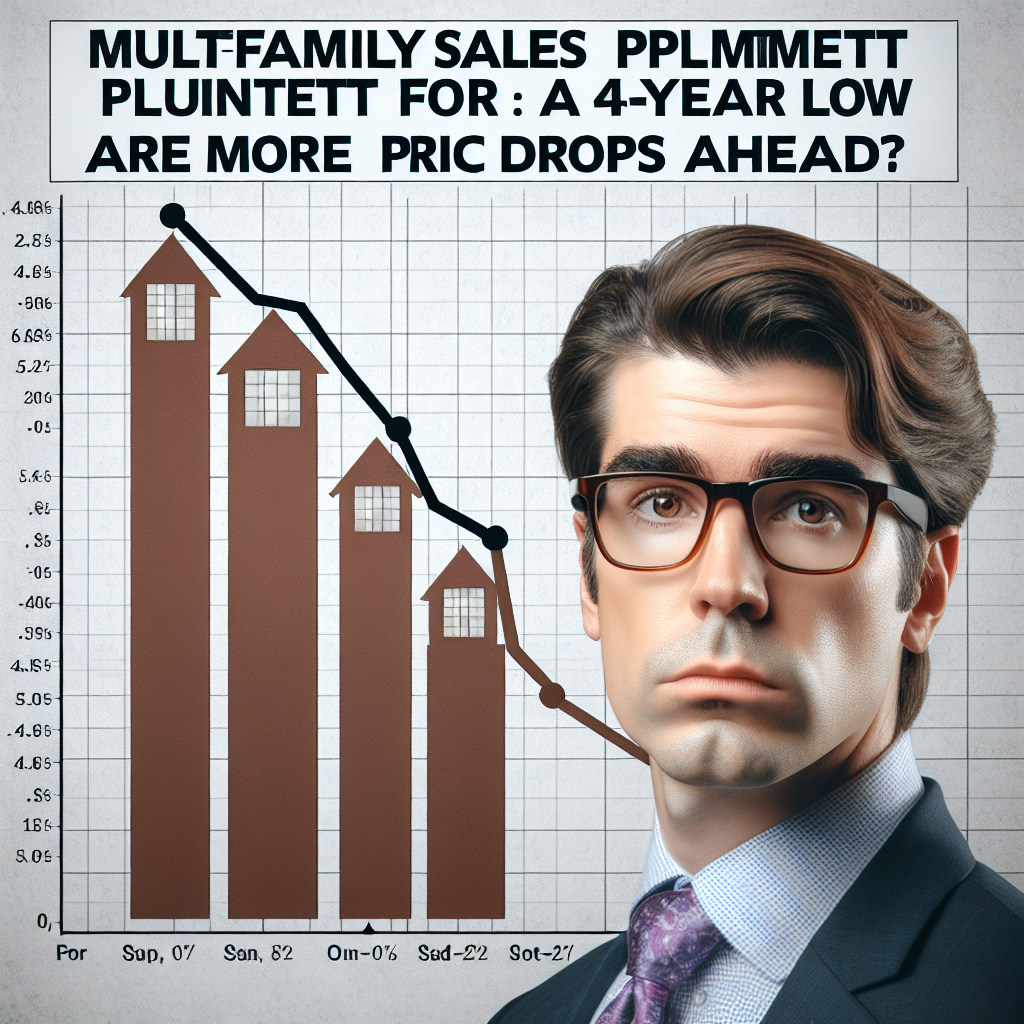-
Table of Contents
- Multifamily Sales Plummet to 4-Year Low: Are More Price Drops Ahead? w/Xander Snyder
- Understanding the Current Market Dynamics
- The Role of Economic Uncertainty
- Impact of Rising Interest Rates
- Supply Chain Disruptions and Construction Costs
- Regulatory Changes and Zoning Laws
- Insights from Xander Snyder
- Case Studies: Cities Affected by the Decline
- New York City
- San Francisco
- Future Outlook: Are More Price Drops Ahead?
- Conclusion
Multifamily Sales Plummet to 4-Year Low: Are More Price Drops Ahead? w/Xander Snyder

The multifamily real estate market has been a cornerstone of urban development and investment for decades. However, recent trends indicate a significant downturn in multifamily sales, reaching a four-year low. This article delves into the factors contributing to this decline, explores potential future price drops, and provides insights from industry expert Xander Snyder.
Understanding the Current Market Dynamics
The multifamily real estate sector has experienced a rollercoaster of changes over the past few years. From the highs of pre-pandemic growth to the lows induced by economic uncertainty, the market has been anything but stable. As of the latest reports, multifamily sales have plummeted to levels not seen in four years. Several factors contribute to this decline:
- Economic Uncertainty: The global economic landscape has been fraught with uncertainty, impacting investor confidence and spending.
- Interest Rates: Rising interest rates have made borrowing more expensive, deterring potential buyers.
- Supply Chain Issues: Ongoing supply chain disruptions have increased construction costs, affecting new developments.
- Regulatory Changes: New regulations and zoning laws have added layers of complexity to multifamily investments.
The Role of Economic Uncertainty
Economic uncertainty has been a significant driver behind the decline in multifamily sales. The COVID-19 pandemic disrupted global economies, leading to job losses, reduced consumer spending, and a general sense of financial instability. Investors, wary of these uncertainties, have become more cautious, opting to hold off on large investments in multifamily properties.
Moreover, the pandemic has altered the way people live and work. Remote work has become more prevalent, reducing the demand for urban multifamily housing as people move to suburban or rural areas. This shift has further dampened the market for multifamily properties in urban centers.
Impact of Rising Interest Rates
Interest rates play a crucial role in real estate investments. When interest rates are low, borrowing is cheaper, making it easier for investors to finance new projects. However, recent hikes in interest rates have made borrowing more expensive, leading to a slowdown in multifamily sales.
According to the Federal Reserve, interest rates have been gradually increasing to combat inflation. This increase has a direct impact on mortgage rates, making it more costly for investors to finance multifamily properties. As a result, many potential buyers are either delaying their purchases or looking for alternative investment opportunities.
Supply Chain Disruptions and Construction Costs
The global supply chain has faced unprecedented disruptions over the past few years. From shipping delays to shortages of essential materials, these disruptions have significantly impacted the construction industry. For multifamily properties, this means higher construction costs and longer project timelines.
Higher construction costs translate to higher prices for new multifamily developments. This increase in prices can deter potential buyers, contributing to the overall decline in sales. Additionally, longer project timelines mean that new properties are taking longer to come to market, further exacerbating the supply-demand imbalance.
Regulatory Changes and Zoning Laws
Regulatory changes and zoning laws have also played a role in the decline of multifamily sales. In many urban areas, new regulations have been introduced to address issues such as affordable housing and environmental sustainability. While these regulations are essential for long-term urban development, they can add layers of complexity and cost to multifamily investments.
For example, new zoning laws may limit the height or density of new developments, reducing the potential return on investment for multifamily properties. Additionally, regulations requiring sustainable building practices can increase construction costs, further impacting the market.
Insights from Xander Snyder
To gain a deeper understanding of the current market dynamics, we spoke with Xander Snyder, a renowned expert in real estate economics. According to Snyder, the decline in multifamily sales is a multifaceted issue that requires a comprehensive approach to address.
“The multifamily market is facing a perfect storm of challenges,” says Snyder. “Economic uncertainty, rising interest rates, supply chain disruptions, and regulatory changes are all contributing to the decline in sales. However, it’s important to note that these challenges also present opportunities for savvy investors who can navigate the complexities of the market.”
Snyder emphasizes the importance of understanding local market conditions and being adaptable in investment strategies. He suggests that investors should focus on areas with strong economic fundamentals and consider alternative financing options to mitigate the impact of rising interest rates.
Case Studies: Cities Affected by the Decline
To illustrate the impact of the decline in multifamily sales, let’s look at two cities that have been significantly affected: New York City and San Francisco.
New York City
New York City has long been a hub for multifamily investments. However, the city has seen a sharp decline in sales over the past year. According to a report by Real Capital Analytics, multifamily sales in New York City dropped by 30% in the first quarter of 2023 compared to the same period in 2022.
The decline can be attributed to several factors, including the high cost of living, regulatory changes, and the shift towards remote work. Many residents have moved to suburban areas, reducing the demand for multifamily housing in the city. Additionally, new regulations aimed at increasing affordable housing have added complexity to new developments, deterring potential investors.
San Francisco
San Francisco is another city that has experienced a significant decline in multifamily sales. The city’s tech-driven economy has been hit hard by the pandemic, leading to job losses and reduced demand for housing. According to data from CBRE, multifamily sales in San Francisco dropped by 25% in 2023 compared to the previous year.
The decline in sales can also be attributed to the high cost of construction and stringent zoning laws. San Francisco has some of the highest construction costs in the country, making it challenging for developers to bring new multifamily properties to market. Additionally, zoning laws that limit the height and density of new developments have further constrained the market.
Future Outlook: Are More Price Drops Ahead?
The decline in multifamily sales raises the question: Are more price drops ahead? While it’s challenging to predict the future with certainty, several factors suggest that the market may continue to face downward pressure in the near term.
- Continued Economic Uncertainty: The global economy is still recovering from the impacts of the pandemic, and new challenges such as inflation and geopolitical tensions could further impact investor confidence.
- Rising Interest Rates: The Federal Reserve has indicated that it may continue to raise interest rates to combat inflation. Higher interest rates will likely continue to make borrowing more expensive, impacting multifamily investments.
- Supply Chain Issues: While some supply chain disruptions are expected to ease, others may persist, leading to continued high construction costs.
- Regulatory Changes: New regulations aimed at addressing affordable housing and sustainability will likely continue to add complexity and cost to multifamily investments.
However, it’s not all doom and gloom. Xander Snyder suggests that there are opportunities for investors who can navigate the complexities of the market. He advises investors to focus on areas with strong economic fundamentals and consider alternative financing options to mitigate the impact of rising interest rates.
Conclusion
The multifamily real estate market is facing significant challenges, with sales plummeting to a four-year low. Economic uncertainty, rising interest rates, supply chain disruptions, and regulatory changes are all contributing to the decline. However, these challenges also present opportunities for savvy investors who can navigate the complexities of the market.
As we look to the future, it’s essential for investors to stay informed about market trends and be adaptable in their investment strategies. By focusing on areas with strong economic fundamentals and considering alternative financing options, investors can position themselves for success in a challenging market.
In summary, while the multifamily market is currently facing headwinds, there are still opportunities for those who are willing to navigate the complexities and adapt to changing conditions. With careful planning and strategic investments, the multifamily sector can continue to be a valuable asset class for investors.








